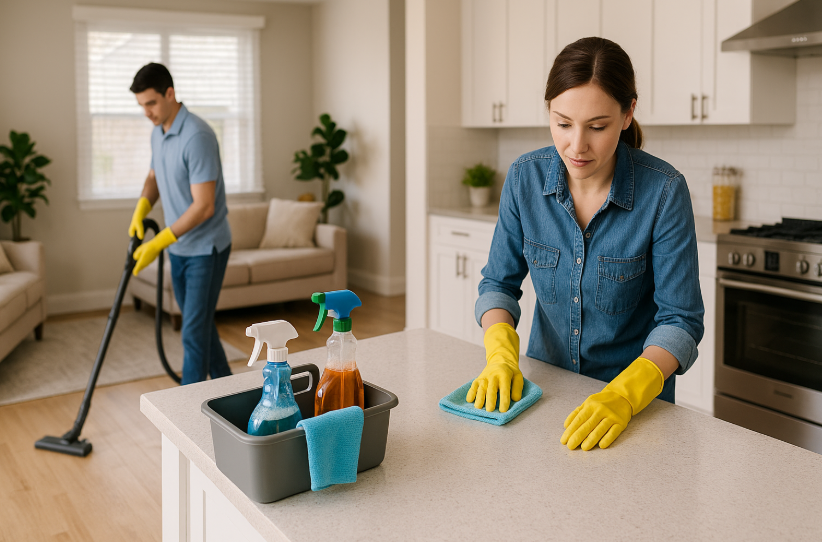
Why Cleaning Consumes 300 Hours a Year and How to Reclaim That Time
If it feels like you are always wiping, scrubbing, and tidying, you are not imagining it. Surveys routinely show that the average person spends about 300 hours a year on household cleaning. That is the equivalent of several full workweeks that could have gone to family, hobbies, or rest. The good news is that most homes do not need heroic all-day scrubbing sessions. With a simple plan, clear time estimates, and a few habit tweaks, you can keep things healthy and presentable without giving up your weekends. If you reach the point where life outgrows your schedule, consider handing the routine over to a nearby company for weekly upkeep near the end of your planning period.
Cleaning time varies for every household. Square footage, the number of people and pets, floor types, and how often you cook all influence the clock. Another major factor is what “clean” means to you. A quick weekly refresh focuses on visible areas and high-touch surfaces. A deep clean adds time for baseboards, blinds, the inside of appliances, and detailed scrubbing. Understanding the difference prevents the never-ending to-do list that steals your evenings.
Here is a reality check you can use to plan your week. For a typical home, a basic living room refresh often falls in the 30 to 60 minute range. Bedrooms take between 20 and 60 minutes each, depending on laundry and clutter. Bathrooms usually take 20 to 45 minutes because they need disinfecting and mineral buildup removal. Kitchens span the widest range, from about 1 to 4 hours, since cooking leaves behind grease and food residue that require more effort than dust. These figures are not rules, but they are helpful benchmarks to build a routine that fits your space. You can see a similar breakdown at the https://maidbrigade.com website.
Living room time, and how to make it shorter
Most living rooms can be reset in under an hour. Start by clearing flat surfaces, then dust from top to bottom, and vacuum or mop last. Soft furnishings collect dust faster than most people realize, so run a hand vacuum over sofas and chairs and rotate cushions while you are at it. If you have a lot of décor, keep a small microfiber cloth in the TV stand and give electronics a light wipe when you sit down. That habit turns a once-a-week chore into a 60-second task and trims the weekend job.
Another time saver is a “landing zone” basket for stray items. Remote controls, game controllers, mail, and school papers drift around the room and slow everything down. A single container keeps them corralled so you can put the room back together without hunting for missing pieces. When you cut the shuffle time, thirty minutes becomes realistic even on busy nights.
Bedrooms go faster with laundry boundaries
A tidy bedroom usually takes 20 to 40 minutes. The big swing up to 60 minutes happens when laundry piles up. Set a simple rule that every person gets one hamper, and it fills only to the top. When it is full, it is laundry day for that person, not the entire household. That small boundary stops laundry from swallowing the room and keeps the weekly reset manageable.
Make the bed first, even if you are changing sheets later. A made bed gives you a clear surface for sorting and folding, and instantly makes the entire space look better. Dust nightstands, lamps, and headboards, then sweep or vacuum under the bed if you can reach it. If you keep a floor-level storage bin for out-of-season items, label it clearly. Labels reduce decision fatigue and shorten cleanups because everything has a home.
See also: Transform Your Home: Expert House Cleaning Tips for a Healthier, Happier Space
Bathrooms demand consistency more than muscle
Bathrooms tend to feel time-consuming because soap scum and hard water do not forgive procrastination. A steady routine is the secret. Keep a small squeegee in the shower and swipe the walls before you step out. Store a non-abrasive cleaner and a dedicated sponge under the sink so you can wipe the sink and faucet while the mirror defogs. These tiny moves cut your weekly bathroom time to the 20 to 30 minute range, even if you have multiple family members.
When it is time for the deeper work, start with the product that needs dwell time. Spray the shower and toilet first so cleaners can break down buildup while you tackle mirrors and counters. By the time you return, the grime releases without heavy scrubbing. Work high to low and finish with the floor. The order matters because repeating steps is the number one time waster in this room.
Why kitchens take the longest, and how to tame them
Kitchens are the heart of the home and the champion time sink. Between cooking, snacks, and endless cups of coffee, residue builds quickly. A weekly refresh often takes about an hour if you stay on top of dishes and wipe spills as they happen. A full clean with degreasing, the inside of the microwave, the sink and disposal, exterior cabinet faces, and the refrigerator can stretch to three or four hours.
The trick is to split tasks into daily micro habits and a standing weekly block. Run the dishwasher every night, even if it is not completely full, and unload it first thing in the morning. That resets the dish cycle so dirty plates never stall in the sink. Give the stovetop a quick wipe after dinner before the heat bakes on the splatter. Keep a sturdy doormat by the exterior door if your kitchen is the main entry point. Less dirt coming in equals fewer passes with the mop.
Once a week, pull small appliances forward, wipe the crumbs behind them, and push them back. Do the same with the fridge handles and light switches. These high-touch areas are where fingerprints collect, and they take seconds to clean when they are part of the routine. Save heavy projects like oven cleaning or a full fridge purge for a monthly deep-clean session so the weekly job does not balloon.
Estimating the total time for your home
If you want a ballpark number for planning, imagine a three-bedroom, two-bathroom home of average size. A weekly refresh of all living areas, bedrooms, bathrooms, and the kitchen often adds up to three to five hours for one person. A monthly deep clean can add two to four more hours if you include baseboards, blinds, ceiling fans, appliance interiors, and shower doors. Larger homes, lots of stairs, or rooms with many decorative items will increase the time. Homes with minimal décor and smart storage can fall on the lower end.
Do not feel locked to a single marathon block. Many people prefer to schedule twenty to forty-minute sessions on weekdays and reserve only a short final pass for the weekend. Others choose one focused morning that frees up the rest of the week. The right answer is the one you will stick to.
A routine that respects your time
Think in zones. Group tasks by location so you are not walking in circles. Keep a small caddy stocked with microfiber cloths, an all-purpose cleaner, a glass cleaner, and a brush. Put it wherever you start most often so the kit is easy to grab. Work top to bottom and left to right so you are always moving forward. Set a timer for each room. A timer switches your brain from perfection to progress, which is exactly what weekly cleaning needs.
If a room consistently blows past the timer, something in that space needs a system. Maybe shoes pile up at the entry, or backpacks land on the dining table. Add a hook rail or a bin, label it, and show the family where things go. Systems beat reminders every time, and they keep your routine inside the clock.
When outside help makes sense
There will be seasons when the calendar is full and the house still needs care. That is when outside help becomes a smart investment. You can start small with a monthly deep clean and keep your existing weekly routine. Many households later decide that a recurring service is the easiest way to hold on to their evenings. It is also a great reset before hosting or after travel, since one professional visit can erase weeks of backlog.
Take back your hours
A clean home supports health and peace of mind, but it should not consume your life. Use realistic time estimates, decide what a weekly refresh includes, and save deep projects for a separate session. Build a few low-effort habits into your days so grime never gets a head start. If your schedule stays crowded, bring in help and protect the hours you reclaimed. Those 300 hours are already in your year. With a plan, you can decide where they go.



